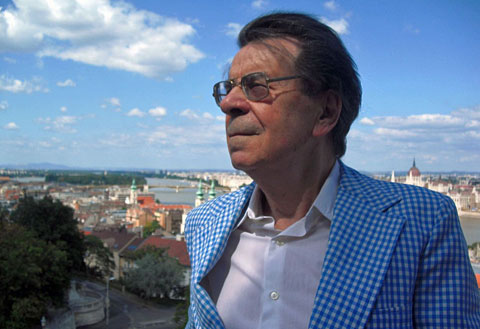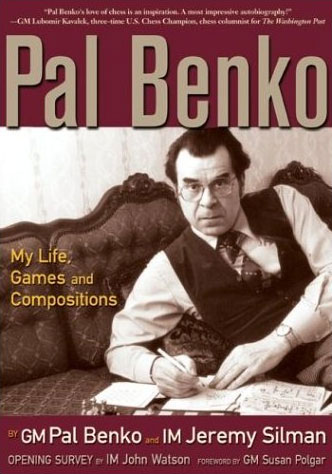Valuation: variations on a famous Kubbel study
By Pal Benkö
Some years ago a discussion arose within the endgame community on a well-known study, which was shown by Frederic Friedel as part of the ChessBase December 30 2014 Christmas puzzle installment. This theme is timely again, so let’s take a look at what started it all by Russian experts.

White to play and win. Solution:

[Event "2/83-17 Shakhmatny Listok"] [Site "?"] [Date "1922.??.??"] [Round "?"] [White "Kubbel, Leonid"] [Black "White to play and win"] [Result "1-0"] [SetUp "1"] [FEN "1N6/8/K7/3k4/3p3B/p7/2PP4/8 w - - 0 1"] [PlyCount "11"] [EventDate "1922.??.??"] 1. Nc6 $3 (1. Bf6 a2 2. c3 (2. c4+ Kxc4 3. d3+ Kxd3) 2... a1=Q+ (2... dxc3 $4 3. Bxc3)) (1. c4+ Kxc4) 1... Kxc6 2. Bf6 Kd5 {Now we have the same position as in the diagram above, except that the knight is gone (and the bishop is on f6). That is progress??} 3. d3 $1 (3. c4+ Kxc4 4. d3+ Kxd3 $19) (3. c3 a2 $19) 3... a2 {The queening of the a-pawn still cannot be prevented.} 4. c4+ Kc5 ({Taking the pawn en passant allows White to recapture with the bishop and stop the pawn:} 4... dxc3 5. Bxc3 $18) 5. Kb7 $1 a1=Q 6. Be7# {[#]This kind of mate is called a model-mate. It means that any square around the doomed king is controlled only once.} 1-0
So the reader may well ask what fault could possibly be found in this work? White’s first move, a showy knight sacrifice, plays no organic part in the solution. In a game a sacrifice may be the completion of an attack. Even then it will not appear to be especially esthetic if it only happens accidentally, as a direct result of the opponent’s mistake. Similarly, the sacrifice is not so pleasing here because its only function is to lengthen the solution. Also consider that when the only reason for a piece is to sacrifice it, that is less artistic. Kubbel was an outstanding author. However, this time he did not presents his theme in his usual best possible way. There are ways to improve this idea.

[Event "Version of Kubble study"] [Site "?"] [Date "1922.??.??"] [Round "?"] [White "Benko/Kubbel, Pal/Leonid"] [Black "White to play and win"] [Result "1-0"] [SetUp "1"] [FEN "K7/N7/7B/3k4/3p4/p7/2PP4/8 w - - 0 1"] [PlyCount "11"] {The solution is the same:} 1. Nc6 {But the knight sacrifice now has a surprising twist, since it uncovers the white king so that when the black pawn promotes it may do so with check.} ({Moving the white king and knight also adds a false try:} 1. c4+ $2 Kxc4 (1... dxc3 $2 2. dxc3 a2 (2... Kc4 3. Bc1) 3. c4+ $1 {wins.}) (1... Ke4 2. Nc6 a2 3. d3+ {[%cal Ge4f3,Ge4f5,Ge4d5,Ge4d3] wins, e.g.} Kxd3 4. Nb4+) 2. d3+ Kxd3 3. Nc6 Kc4 4. Bg7 d3 5. Ne5+ Kc3 {only leads to a draw.}) 1... Kxc6 2. Bg7 Kd5 3. d3 a2 4. c4+ Kc5 5. Kb7 a1=Q 6. Bf8# 1-0
Of course, it is still better if all the pieces cooperate in the actual solution.

[Event "Version of Kubble study"] [Site "?"] [Date "1922.??.??"] [Round "?"] [White "Benko/Kubbel, Pal/Leonid"] [Black "White to play and win"] [Result "1-0"] [SetUp "1"] [FEN "8/6N1/K2k3B/4p3/8/p7/2PP4/8 w - - 0 1"] [PlyCount "13"] 1. Nf5+ Ke6 {There are no better moves.} (1... Kd5 2. Ne3+ {[%cal Gc2c4,Ge3c2] followed by c4 and 4.Nc2 wins.}) 2. Nd4+ exd4 3. Bg7 Kd5 4. d3 a2 5. c4+ Kc5 6. Kb7 a1=Q 7. Bf8# 1-0
Here the knight moves twice and changes the pawn structure with its sacrifice. In this way the play is more dynamic and at the same time the solution is more difficult.
– Part two about versions without the knight will follow soon –

Pál Benkö, 86, is a Hungarian-American chess grandmaster, openings theoretician, author and problemist. He became Hungarian champion when he was 20 and finished in first place (or tied for first place) in eight US Championships, a record: 1961, 1964 (in that year he also won the Canadian Open Chess Championship), 1965, 1966, 1967, 1969, 1974, 1975. Benko's highest achievements were playing in the Candidates Tournament with eight of the world's top players in 1959 and 1962. He qualified for the 1970 Interzonal tournament, the leaders of which advance to the Candidates. However, he gave up his spot in the Interzonal to Bobby Fischer, who went on to win the World Championship in 1972.
In addition to his success as a player, Benko is a noted authority on the chess endgame and a composer of endgame studies and chess problems. He is an over-the-board GM and also a FIDE IM of chess composition. The only other person we know who has these two titles is Jan Timman of the Netherlands.
Pal Benkois also a dear friend who keeps in touch with us regularly, sending problems and puzzles for the ChessBase news page on special occasions.
 |
This biography is a celebration of a great man's creative legacy, an amazing collection of 138 deeply annotated games which have been carefully prepared to be entertaining, enlightening, and instructive. They are brought to life by Benko's memoirs of his early years in war-torn Hungary, a world of poverty, chaos, pain, and ultimately, personal triumph. His insights into famous grandmasters transform legends into real people with substance and personality, and his reminiscences of famous tournaments take us on a journey through chess history unlike anything that's been published before. A massive survey of Benko's openings shows us the scope of his theoretical contributions to the game. Photos abound, and 300 of Benko's chess compositions allow lovers of the game to become intimately acquainted with a strikingly beautiful aspect of chess that most have overlooked.
This highly entertaining and instructive book gives competitors who wish to improve their playing strength a dynamic, fun way to deepen their knowledge and understanding.
|
Some earlier ChessBase articles by and about Pal Benko
12/31/2014 – Happy New Year 2015 from Pal Benko
Our friend, famous chess composer GM Pal Benko, got into the New Year spirit by sending us seven little problems to solve. They are all miniatures, requiring mate in three moves. And together they spell out HNY-2015. The positions look deceptively easy, but some have very clever solutions that are not easy to find. All are cook free. With Pal we wish our readers a Happy New Year 2015!
4/4/2014 – Benko: Fun problems to celebrate April 1st
Our friend and world famous chess composer GM Pal Benko got into the spirit of the day and sent us three problems to solve. They look deceptively easy, but you must consider the day of publication and not be fooled by the guile of the composer. We will leave you to work things out for a few days, and then give you the answers which may come as a surprise to some.
3/29/2014 – Pal Benko on Richard Réti’s endgames (2)
125 years ago a boy was born in the Austro-Hungarian part of what is today Slovakia. Richard Reti was a mathematician and world class chess master. Reti was also an endgame specialist who composed some of the most original endgame studies ever devised. Some were flawed, and now, almost a century later, his compatriot GM Pal Benko provides revisions to these studies.
3/26/2014 – Pal Benko on Richard Réti’s endgames (1)
At the turn of the last century an Austro-Hungarian mathematician shook up the chess world with revolutionary new ideas ("hypermodernism"), and with some of the most original endgame studies ever devised. To celebrate his upcoming 125th birthday another great chessplayer and endgame specialist, GM Pal Benko, has sent us some examples of Reti's works.
12/23/2013 – Pal Benko: Secrets of Study Composition (2)
One of the greatest study composers – as well as a former world championship candidate – is our friend Pal Benko, who never fails to send us a special Christmas gift. This year it was an article that offers unique insight into the process of chess composition. We brought you the first part a week ago. Today it is about breaking the pin and avoiding stalemate. And there is a remarkable study for you to solve.
12/17/2013 – Pal Benko: Secrets of Study Composition (1)
There is more to chess than tournament games. The area of chess studies and problems is equally creative and breathtakingly imaginative. One of its greatest composers is grandmaster (and world championship candidate 1959 + 1962) Pal Benko. The 85-year-old author of some of the most famous studies of all time has sent us an essay on the remarkable process of chess composition.
7/15/2013 – The Life Gambit à la Benko
Pal Benko (Hungarian: Benkö Pál) is, as 99% of our readers probably know, a legendary chess grandmaster, author, and composer of endgame studies and problems. He was born on July 15 1928, which made him 85 today. Diana Mihajlova met the fit and active octogenarian, who has been a "pal" of our company for a decade, in his home town of Budapest. Here is part one of her birthday report.
7/18/2013 – The Life Gambit à la Benko – Part two
On Monday Pal Benko, legendary grandmaster, author, and problem composer, turned 85. Diana Mihajlova, who recently met with the fit and active octogenarian in his home town of Budapest, sent us a birthday report in two parts. Today we learn of Benkos escape from Communist Hungary to the US, and his relationship with Bobby Fischer. And we get to solve two highly entertaining problems.
5/20/2011 – Greetings from Pál Benkö for 25 years of ChessBase
"Congratulations to ChessBase on your 25th anniversary! Your news page is the the first thing I look at every day when I go on the Internet. You do such wonderful work. Keep up your great service for the whole chess world." Heartening words from legendary great chess player, theorist, author and problem composer – who in addition sent six anniversary puzzles for our readers.
4/24/2011 – Easter puzzles by Benko – a World Champion challenge
Pál Benkö, 82 and still going strong, is a world class grandmaster, author and problem composer. He is also a faithful friend who periodically sends us puzzles for our newspage. This time, for Easter, he has selected four problems which stumped a World Champion. It is a challenge for you to do better, and win a special prize in the process. Enjoy.
12/30/2009 – Pal Benko improves on Troitzky
In 1856 the great Sam Loyd composed a chess problem, which 75 years later inspired Alexey Troitsky, one of the greatest composers of endgame studies, to create a puzzle with a similar theme. It proved to be flawed. 75 years after Troitzky another great composer, Pal Benko, took up his problem, improved on it and submitted it for our Christmas Puzzle page.



























